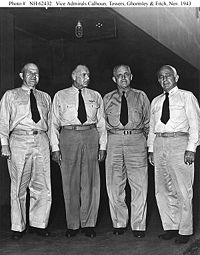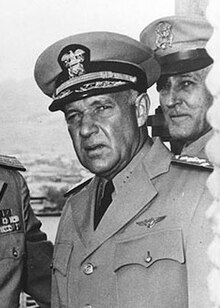John Henry Towers
John Henry "Jack" Towers (born January 30, 1885 in Rome , Floyd County , Georgia ; † April 30, 1955 in Queens , New York City ) was an American naval aviator and admiral in the US Navy , who last served from 1946 to 1947 was in personal union Commander in Chief of the Pacific Command ( US Pacific Command ) and Commander in Chief of the Pacific Fleet ( US Pacific Fleet ) . For his aviation services he was posthumously inducted into the National Aviation Hall of Fame in 1966.
Life
Training as a naval officer and aviator
After attending school, Towers began his officer training at the US Naval Academy in Annapolis , which he graduated in 1906. He then took first use on the Kearsarge class belonging to pre-dreadnought battleship USS Kentucky . In the following years he applied several times as a naval aviator before he was admitted as a lieutenant captain (Lieutenant) on June 27, 1911 for training at the flight school founded by Glenn Curtiss in Hammondsport . There he was trained after Theodore Gordon Ellyson and John Rodgers on the first aircraft of the US Navy Curtiss A-1 to the third naval lavender.
On October 25, 1911, Ellyson and Towers flew an overland flight of 180 km in 122 minutes along Chesapeake Bay from Annapolis to Old Point Comfort . He later took over the training of new naval aviators as a flight instructor himself and in October 1912 set a record for long-term flight recordings for naval aviators along Chesapeake Bay when he flew six hours with an additional tank. In December 1912 he completed experiments that proved the possibility of sighting submarines from the air. In 1913 he was responsible for the aviation unit that took part in the first maneuvers with the US fleet from the Guantanamo Bay Naval Base . He and the other pilots explored the aircraft's potential to support the Navy through aerial reconnaissance, bombing, aerial photography and wireless communication. They also succeeded in sighting submarines at a depth of 9 to 12 meters.
On 20 June 1913, Towers was on board one of Ensign (Ensign) William Billingsley flown hydroplane type Navy Wright B-2 . The machine got into violent turbulence over Chesapeake Bay at a height of around 600 meters, as a result of which Billingsley was thrown from his seat, fell to his death in the water below and thereby became the first naval aviator to be killed in service. Towers managed to climb into the pilot's seat and crash-land the plane, which he survived almost unharmed. He then ordered the use of seat belts in all naval aircraft. In January 1914 he was responsible for the construction of the Naval Air Station Pensacola , the first naval aviation base in the USA.
First World War, ship commander and merits in naval aviation

Then Towers was from August 1914 to August 1916 Deputy Naval Attaché at the Embassy in the United Kingdom and then took part in a mission on the armored cruiser USS Tennessee . In May 1917, he was appointed as Lieutenant Commander (Lieutenant Commander) to the navigation office of the Navy (Bureau of Navigation) offset, where he worked for the Naval Air Reserve Corps NRFC (Naval Reserve Flying Corps) was responsible. After the worsening of the submarine war and the USA's entry into the First World War in 1917, he directed naval aviation missions in the Gulf of Mexico from there . In April 1919 he tried together with Patrick NL Bellinger and Albert Cushing Read with a group of three seaplanes of the type Curtiss NC of the Rockaway Naval Air Station from Newfoundland on May 8, 1919 to cross the Atlantic Ocean , but had to use his airplane NC- 2 made an emergency landing around 205 nautical miles off the Azores , as did one of the other two aircraft. The third NC-4 aircraft under Read made the transatlantic flight to England after a stopover in the Azores and Portugal . For his services to this he was awarded the Navy Cross .
Then Towers was first officer of the minelayer USS Aroostock and from 10th December 1920 to December 1921 Commander ( Commanding Officer ) of the destroyer USS Mugford , before 1921 as first officer of the Marine airbase Pensacola on behalf of the aviation office of the Navy (Bureau of Aeronautics) with the Training of naval aviators on normal aircraft began. This was necessary to ensure future use on aircraft carriers . In 1922 the US Navy had the naval coal transporter USS Jupiter converted into USS Langley , the first aircraft carrier in the USA. The previous training gradually solved the practical problems of using aircraft from ships. In the following years, safety ropes and barricades were developed to support the safety of the landings. This was followed by the conversion of the USS Lexington and the USS Saratoga to the second and third operational aircraft carriers in the USA before the Second World War .

Towers itself was between March 1923 and September 1925 successively deputy naval attaché at the embassies in the United Kingdom, France , Italy , the Netherlands and most recently in Germany . On his return he was appointed by the Bureau of Aeronautics to investigate the accident involving the rigid airship USS Shenandoah . After serving as first officer on January 4, 1927, he finally succeeded Captain Frank Robert McCrary as the commander of the aircraft carrier USS Langley and remained in this position until his replacement by frigate captain Robert Rudolf "Rip" Paunack on January 26, 1927. August 1928. He was then head of the planning department and then deputy chief of the Bureau of Aeronautics , before he became an officer on the staff of Rear Admiral Harry E. Yarnell in June 1931 , who was at the time commanding the naval aviation units of the Battleship Association (Battle Force) .
After Towers had completed a staff course at Naval War College in Newport from June 1933 to 1934 , he was commandant of Naval Air Station San Diego and then again an officer in the staff of the commander of the naval aviation units of the battleship association. After that, he has served as the Captain (Captain) on June 9, 1937 Captain William Halsey as commander of the aircraft carrier USS Saratoga , and remained in this use until its replacement by Captain Albert Cushing Read on June 16, 1938 .
Promotion to admiral and World War II

Then Towers was first again deputy chief of the Bureau of Aeronautics before he succeeded by Rear Admiral Arthur B. Cook finally, on June 1, 1939 even head of the Bureau of Aeronautics and Rear Admiral (Rear Admiral) was promoted. He was the first naval aviator in the history of the US Navy to be promoted to the rank of admiral. On the post as head of the Bureau of Aeronautics , he remained until October 9, 1942 and was then Rear Admiral John S. McCain, Sr. replaced. During his service, the number of naval aircraft grew from 2,000 in 1939 to 39,000 in 1942.
After his promotion to Vice Admiral (Vice Admiral) on October 6, 1942 Towers was commander of the air units of the US Pacific Fleet. He then became Deputy Commander-in-Chief of the Armed Forces in the Pacific Ocean Area and Deputy Commander-in-Chief of the Pacific Fleet and, as Admiral Chester W. Nimitz's deputy, was his chief advisor for naval aviation operations, fleet logistics and administrative matters. On February 27, 1944 he was awarded the Legion of Merit and on July 23, 1945 with the Navy Distinguished Service Medal . In August 1945 he became commander of the Second aircraft carrier task forces (Second Carrier Task Force) as well as the aircraft carrier forces 38 ( Taskforce 38 ) , before November 7, 1945 as Admiral Commander of the US 5th Fleet (US Fifth Fleet) with the battleship USS New Jersey was the flagship .
Subsequently, on February 1, 1946, Towers succeeded Admiral Raymond A. Spruance himself as Commander in Chief of the Pacific Fleet ( US Pacific Fleet ) with the aircraft carrier USS Bennington as the flagship. A post he held until his replacement by Admiral Louis E. Denfeld on 28 February 1947. On 1 January 1947 he has also been in personal union commander in chief of the newly created US Pacific Command ( US Pacific Command ) and was also in this use at 28 Released February 1947 by Admiral Louis E. Denfeld. He then acted from March until his retirement on December 1, 1947 as chairman of the General Board of the United States Navy , an advisory body to the US Navy.
After his death he was buried in Arlington National Cemetery. He was married to Pierrette Anne Towers.
Awards
Selection of decorations, sorted based on the Order of Precedence of the Military Awards:
Web links
- Entry on the Arlington National Cemetery homepage
- John Henry Towers in the database of Find a Grave (English)
- Entry in the Hall of Valor
Individual evidence
- ↑ USS MUGFORD (DD-105) (navsource.org)
- ↑ USS LANGLEY (CV-1) : Commanding Officers (navsource.org)
- ↑ USS SARATOGA (CV-3) : Commanding Officers (navsource.org)
- ^ Bureau of Aeronautics
- ^ Secretaries of the Navy and Key United States Naval Officers, 1950 - 1975 on the homepage of the Naval History and Heritage Command
| personal data | |
|---|---|
| SURNAME | Towers, John Henry |
| ALTERNATIVE NAMES | Towers, Jack (nickname) |
| BRIEF DESCRIPTION | US Navy Admiral |
| DATE OF BIRTH | January 30, 1885 |
| PLACE OF BIRTH | Rome , Floyd County , Georgia |
| DATE OF DEATH | April 30, 1955 |
| Place of death | Queens , New York City |

